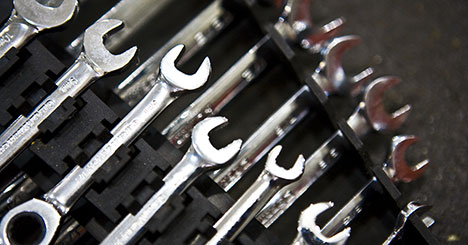

June 12, 2017
One of the most pressing issues facing business aviation maintenance technicians, flight departments and MROs right now is how to meet directives regarding positive control of all tools to eliminate incidents and accidents due to tool FOD.
“It’s a hot button for FAA audits,” according to Kent Stauffer, vice president of quality, safety and technical programs for Constant Aviation and also a member of the NBAA Safety Committee.
Stauffer’s organization is currently going through an FAA Certificate Holder Evaluation Process (CHEP) audit.
“I can tell you that there are at least 10 audit elements that deal in some way with tool control. Just having technicians look in their toolboxes and say they have everything is not an acceptable answer anymore,” said Stauffer.
New digital tool-tracking systems that use radio frequency identification (RFID) chips on every tool, or full-drawer scanning systems to record every tool removed from a toolbox, are solutions that Stauffer and Constant Aviation are considering. Systems by HABCO, 3M, Snap-on and others produce the positive tool control needed to achieve sufficient accountability, but such systems come at a significant cost.
“Right now, RFID chip technology and full-drawer scanners are the solution, but adaptation of these systems is neither economical or easy,” Stauffer said.
The topic of positive tool control is very important to the NBAA Safety Committee, according to Eli Cotti, NBAA’s director of technical operations. While the NBAA Management Guide addresses the basic premise of tool control, “The ultimate responsibility and discipline is that of the individual first and foremost; technology can and should assist, but not replace, personal discipline,” he said.
The NBAA Management Guide provides guidance related to proper handling and calibration of precision tools. For example, methods of proper tracking of precision-tool calibration intervals, and maintaining effective control methods for tracking when a tool was used on a specific aircraft, are addressed.
In fact, accounting for every tool used is a critical part of any maintenance task performed on business aircraft. But achieving this positive tool control can be challenging, and is currently is being handled in various ways by different maintenance departments. Cox Enterprises’ senior director of aviation maintenance, Steve King, said, “We are accomplishing tool control by using a complete inventory, and photos of each toolbox drawer. We use a company that provides shadowed toolbox drawer inserts from photographs. As an IS-BAO-certified flight operation, our goal is to meet the International Standard for Business Aircraft Operations (IS-BAO) standards for all aspects of our operation, including tool control.”
Nathan Winkle, Yum Restaurant Services Group director of aviation maintenance, said his company provides tools and toolboxes for their technicians. “We have three business jets based throughout the country, and because we trade technicians from site to site, the toolboxes are identical, and only the technicians have access to those three toolboxes using a card reader. Any tool control program should fit the scope, culture and size of the group where it is applied. Some companies may need a full-drawer scanning system, while others just need to shadow their boxes and have personal accountability.”
Review maintenance tool resources in NBAA’s Product and Services Directory


 International Business Aviation Council Ltd.
International Business Aviation Council Ltd.